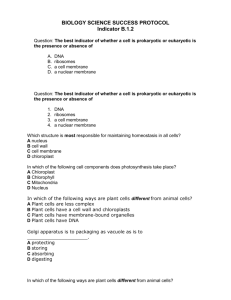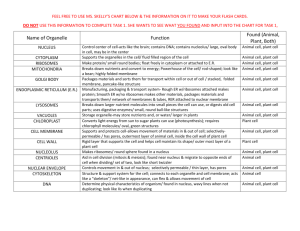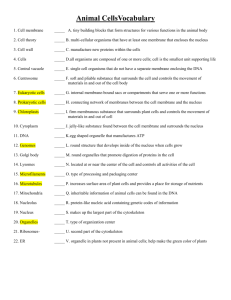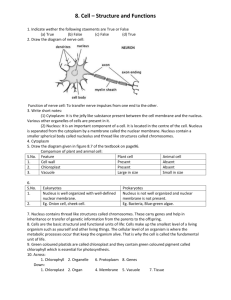Independent and Dependent variables.
advertisement
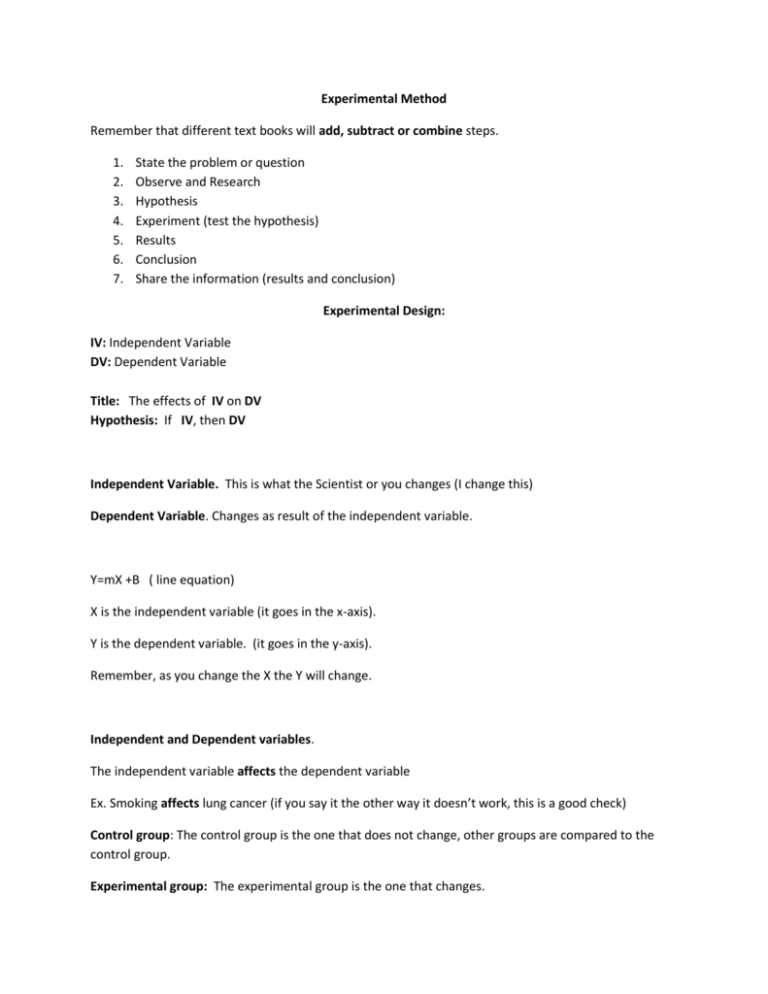
Experimental Method Remember that different text books will add, subtract or combine steps. 1. 2. 3. 4. 5. 6. 7. State the problem or question Observe and Research Hypothesis Experiment (test the hypothesis) Results Conclusion Share the information (results and conclusion) Experimental Design: IV: Independent Variable DV: Dependent Variable Title: The effects of IV on DV Hypothesis: If IV, then DV Independent Variable. This is what the Scientist or you changes (I change this) Dependent Variable. Changes as result of the independent variable. Y=mX +B ( line equation) X is the independent variable (it goes in the x-axis). Y is the dependent variable. (it goes in the y-axis). Remember, as you change the X the Y will change. Independent and Dependent variables. The independent variable affects the dependent variable Ex. Smoking affects lung cancer (if you say it the other way it doesn’t work, this is a good check) Control group: The control group is the one that does not change, other groups are compared to the control group. Experimental group: The experimental group is the one that changes. Living Things Basic needs of living things Shelter water food air Characteristics of living things Use energy, Respond to environment (stimulus), Cells, DNA, Grow and develop, Reproduce The Cell Discovery of the Cell The zoologist who concluded that animal tissues are made of cells Theodor Schwann . The scientist who described “animalcules”, and is sometimes credited with creating the first microscope Anton Van Leeuwenhoeck. The botanist who concluded that plant tissues are made of cells Mathias Schleiden. The scientist who described and first named the “cell” Robert Hooke . The pathologist who concluded that all cells come from other cells Rudolph Virchow. Cell Theory 1. Cells come from pre-existing cells 2. The cell is the basic unit of life 3. All organism are made of one or more cells Prokaryotes No nucleus pro=before karyo=nucleus Eukaryotes Has nucleus eu=true karyo=nucleus Circular DNA Linear DNA No membrane bound organelles Membrane bound organelles Older Newer simple Complex Bacteria, cyanobacteria (green algae) Animal, plant, fungi (yeast), protist Plant Animal Cell wall Chloroplast Big central vacuole Nucleus Nucleolus Cell membrane Cell wall Vacuole Mitochondria Lysosome Golgi complex ER Chloroplast Nuclear membrane Ribosomes Cell wall Cell membrane Nucleus Nucleolus Vacuole Mitochondria Lysosome Golgi complex ER Ribosomes Centrosomes Chloroplast Centriole Flagella pilli Small vacuoles Centriole Cell Function Control center of the cell. Contains DNA Makes ribosomes Controls what enters and exits the cell Protects and supports the cell (plants and bacteria) Storage tank for water, nutrients and waste Power house. Produces energy in the form of ATP Destroys damaged organelles, proteins Packages and transport material (in vesicles) within and out of the cell. (Fedex of the cell). Transportation system of the cell (transports vesicles to Golgi) Uses sun light energy to make food (glucose) Membrane that surrounds the nucleus Makes proteins Plant ooooooooooooooooo ooooooooooooooooo ooooooooooooooooo ooooooooooooooooo ooooooooooooooooo ooooooooooooooooo ooooooooooooooooo ooooooooooooooooo ooooooooooooooooo ooooooooooooooooo ooooooooooooooooo ooooooooooooooooo Animal ooooooooooooooooo ooooooooooooooooo ooooooooooooooooo ooooooooooooooooo ooooooooooooooooo ooooooooooooooooo ooooooooooooooooo ooooooooooooooooo ooooooooooooooooo ooooooooooooooooo ooooooooooooooooo ooooooooooooooooo Bacteria ooooooooooooooooo ooooooooooooooooo oooooooooooooooooo ooooooooooooooooo ooooooooooooooooo Cell membrane Cytoplasm Cell wall DNA Ribosomes Pili Flagella Cell Transport, diffusion, osmosis Diffusion The movement of particles from high to low concentration. Osmosis The movement of water from high to low concentration across the cell membrane. “water follows the solute” Rememberthe solutes usually do not move Passive transport The movement of molecules across the cell membrane from areas of high concentration to areas of low concentration (diffusion). It does not require energy these molecules are small: water, carbon dioxide, oxygen potassium, sodium etc. Active transport The movement of large molecules across the cell membrane from areas of low concentration to areas of high concentration (against diffusion). It requires energy (ATP), these molecules are big: amino acids, carbohydrates, proteins. Endocytosis Endo “within” cyto “cell”. The process by which cells engulf materials inside the cell. Exocytosis Exo “outer” cyto “cell”. The process by which cells release (secrete) materials outside the cell. Endocytosis Exocytosis



